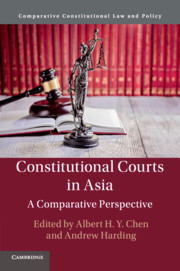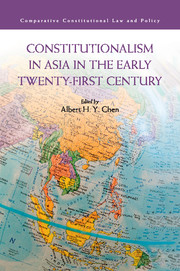27 results
4 - Constitutions and Constitutionalism: China
- from II - Concepts and Definitions
-
-
- Book:
- Constitutionalism in Context
- Published online:
- 17 February 2022
- Print publication:
- 17 February 2022, pp 61-86
-
- Chapter
- Export citation
8 - The Constitutional Orders of ‘One Country, Two Systems’
- from Part II - The View from Asia Pacific and the Middle East
-
-
- Book:
- The Invisible Constitution in Comparative Perspective
- Published online:
- 02 November 2018
- Print publication:
- 08 November 2018, pp 230-267
-
- Chapter
- Export citation
Preface
-
- Book:
- Constitutional Courts in Asia
- Published online:
- 17 September 2018
- Print publication:
- 20 September 2018, pp xvii-xviii
-
- Chapter
- Export citation
Figures
-
- Book:
- Constitutional Courts in Asia
- Published online:
- 17 September 2018
- Print publication:
- 20 September 2018, pp ix-ix
-
- Chapter
- Export citation
Index
-
- Book:
- Constitutional Courts in Asia
- Published online:
- 17 September 2018
- Print publication:
- 20 September 2018, pp 365-388
-
- Chapter
- Export citation
Tables
-
- Book:
- Constitutional Courts in Asia
- Published online:
- 17 September 2018
- Print publication:
- 20 September 2018, pp x-x
-
- Chapter
- Export citation
Copyright page
-
- Book:
- Constitutional Courts in Asia
- Published online:
- 17 September 2018
- Print publication:
- 20 September 2018, pp vi-vi
-
- Chapter
- Export citation
1 - Constitutional Courts in Asia
-
-
- Book:
- Constitutional Courts in Asia
- Published online:
- 17 September 2018
- Print publication:
- 20 September 2018, pp 1-31
-
- Chapter
- Export citation
Contents
-
- Book:
- Constitutional Courts in Asia
- Published online:
- 17 September 2018
- Print publication:
- 20 September 2018, pp vii-viii
-
- Chapter
- Export citation
Contributors
-
- Book:
- Constitutional Courts in Asia
- Published online:
- 17 September 2018
- Print publication:
- 20 September 2018, pp xi-xvi
-
- Chapter
- Export citation

Constitutional Courts in Asia
- A Comparative Perspective
-
- Published online:
- 17 September 2018
- Print publication:
- 20 September 2018
7 - Hong Kong’s Judiciary under ‘One Country, Two Systems’
-
-
- Book:
- Asia-Pacific Judiciaries
- Published online:
- 07 December 2017
- Print publication:
- 21 December 2017, pp 131-168
-
- Chapter
- Export citation
Constitutionalism in Asia in the Early Twenty-First Century - Half title page
-
- Book:
- Constitutionalism in Asia in the Early Twenty-First Century
- Published online:
- 05 July 2014
- Print publication:
- 17 April 2014, pp i-i
-
- Chapter
- Export citation
Contents
-
- Book:
- Constitutionalism in Asia in the Early Twenty-First Century
- Published online:
- 05 July 2014
- Print publication:
- 17 April 2014, pp v-vi
-
- Chapter
- Export citation
Copyright page
-
- Book:
- Constitutionalism in Asia in the Early Twenty-First Century
- Published online:
- 05 July 2014
- Print publication:
- 17 April 2014, pp iv-iv
-
- Chapter
- Export citation
Index
-
- Book:
- Constitutionalism in Asia in the Early Twenty-First Century
- Published online:
- 05 July 2014
- Print publication:
- 17 April 2014, pp 416-435
-
- Chapter
- Export citation
Tables
-
- Book:
- Constitutionalism in Asia in the Early Twenty-First Century
- Published online:
- 05 July 2014
- Print publication:
- 17 April 2014, pp viii-viii
-
- Chapter
- Export citation
Figures
-
- Book:
- Constitutionalism in Asia in the Early Twenty-First Century
- Published online:
- 05 July 2014
- Print publication:
- 17 April 2014, pp vii-vii
-
- Chapter
- Export citation
Series page
-
- Book:
- Constitutionalism in Asia in the Early Twenty-First Century
- Published online:
- 05 July 2014
- Print publication:
- 17 April 2014, pp ii-ii
-
- Chapter
- Export citation

Constitutionalism in Asia in the Early Twenty-First Century
-
- Published online:
- 05 July 2014
- Print publication:
- 17 April 2014



